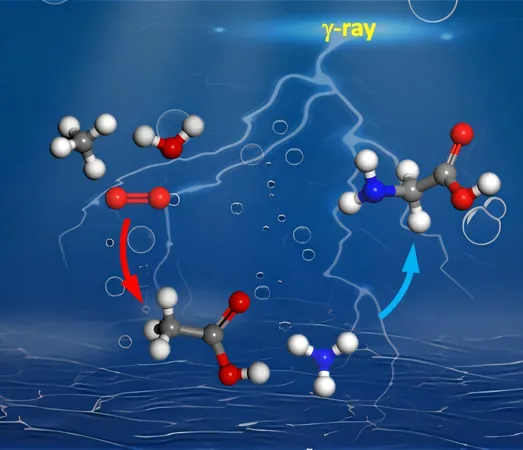
Groundbreaking Discovery: Gamma Radiation Transforms Methane into Life's Building Blocks!
2024-11-06
Author: Yu
Introduction
In an astonishing development that could reshape our understanding of life's origins, researchers have found that gamma radiation can convert methane—a simple hydrocarbon—into an array of complex organic molecules, including amino acids, under room temperature conditions. This cutting-edge research, published in the prestigious journal *Angewandte Chemie International Edition*, suggests a profound link between cosmic chemistry and the genesis of life on Earth.
Research Overview
Led by the talented Weixin Huang from the University of Science and Technology of China in Hefei, this research unveils the potential of gamma rays—high-energy photons emitted from cosmic rays and radioactive decay—to facilitate essential chemical reactions in space. "Gamma rays can provide the energy required for simple molecules, like methane (CH4), to react and form more complex structures, possibly in the icy environments of interstellar dust and ice grains," Huang explained.
Methodology
Historically, most investigations into cosmic processes have utilized extreme vacuum and low-temperature simulations. However, Huang's team innovatively studied the behavior of methane under gamma radiation at room temperature, showcasing how it interacts in both gas and liquid phases.
Findings
The findings revealed striking variations based on the conditions: when pure methane is exposed to gamma rays, it produces basic hydrocarbons like ethane and propane, albeit with low efficiency. However, the introduction of oxygen amplifies these reactions significantly, yielding carbon dioxide, carbon monoxide, ethylene, and water.
Further Analysis
Moreover, adding water transformed aqueous methane into acetone and tertiary butyl alcohol, while the gas-phase reactions favored the production of ethane and propane. Even more compelling, when both oxygen and water were present, the reactions accelerated dramatically. The resulting substances included formaldehyde and acetic acid, with the presence of ammonia leading to the synthesis of glycine—an amino acid that has been detected in extraterrestrial environments.
Conclusion
Huang's team meticulously mapped out a reaction pathway whereby glycine can originate from fundamental cosmic ingredients: methane, oxygen, water, and ammonia. This research not only strengthens the theory of biogenic molecules forming in space but also raises the possibility that life's building blocks might be more abundant throughout the universe than previously imagined.
Implications for Astrobiology
The crucial role of *O2−* and *OH* radicals in these reactions suggests that such processes could also occur in environments far beyond Earth, opening the door for more profound insights into astrobiology and the universal potential for life.
Role of Cosmic Dust
Additionally, the researchers found that various solid materials, components of cosmic dust—like silicon dioxide, iron oxide, magnesium silicate, and graphene oxide—can significantly influence the selectivity of the products formed during these reactions. This indicates that the rich and varied composition of interstellar dust might have played a pivotal role in the uneven distribution of organic molecules observed throughout the cosmos.
Industrial Applications
This groundbreaking study not only revolutionizes our understanding of organic synthesis in space but also paves the way for innovative industrial applications. With the potential to convert methane into valuable chemical products under mild conditions, this research could lead to sustainable methods for utilizing methane, a prominent greenhouse gas, thereby addressing environmental challenges while exploring the origins of life itself!
Final Thoughts
Keep an eye on this exhilarating field—it may unlock secrets that humanity has pondered for centuries!



 Brasil (PT)
Brasil (PT)
 Canada (EN)
Canada (EN)
 Chile (ES)
Chile (ES)
 España (ES)
España (ES)
 France (FR)
France (FR)
 Hong Kong (EN)
Hong Kong (EN)
 Italia (IT)
Italia (IT)
 日本 (JA)
日本 (JA)
 Magyarország (HU)
Magyarország (HU)
 Norge (NO)
Norge (NO)
 Polska (PL)
Polska (PL)
 Schweiz (DE)
Schweiz (DE)
 Singapore (EN)
Singapore (EN)
 Sverige (SV)
Sverige (SV)
 Suomi (FI)
Suomi (FI)
 Türkiye (TR)
Türkiye (TR)